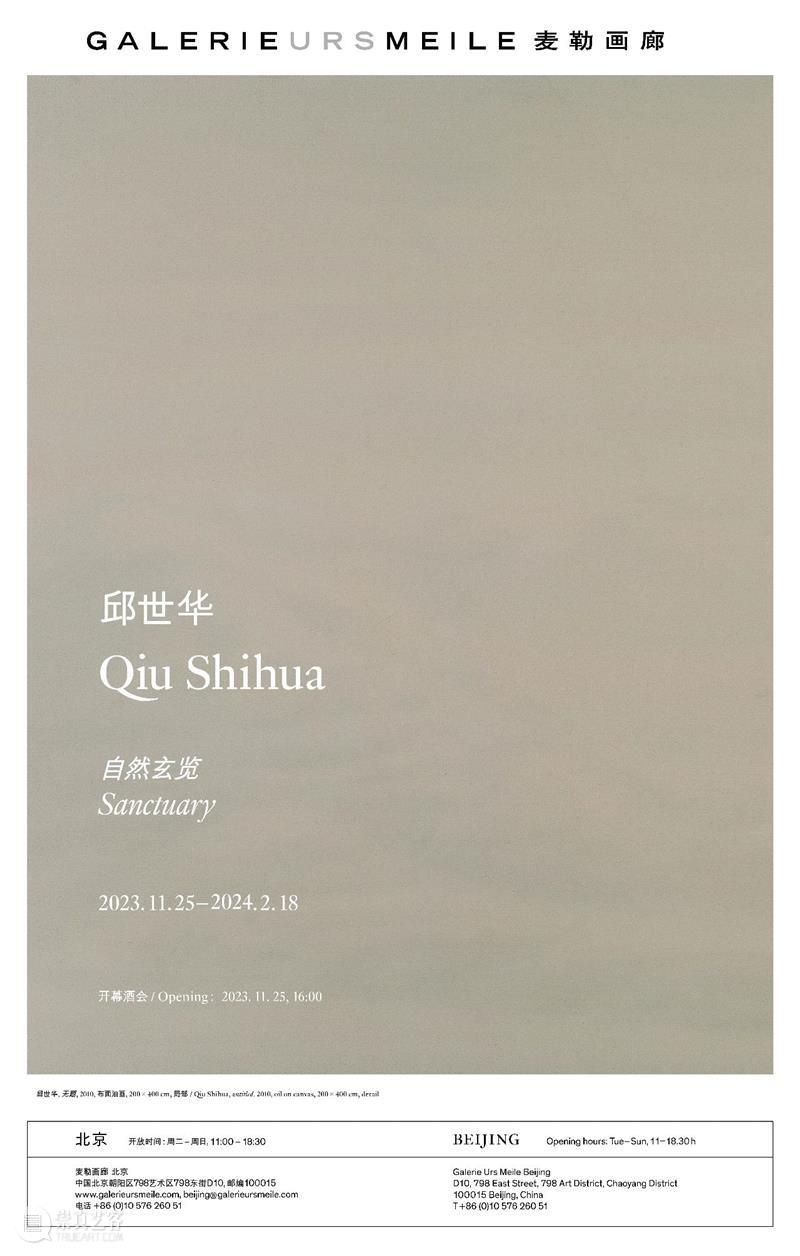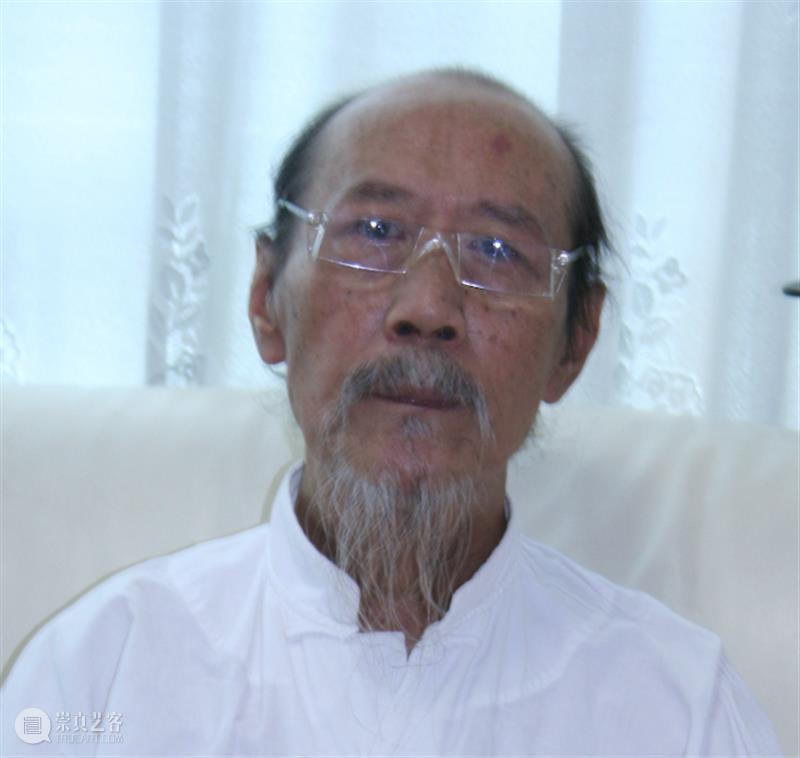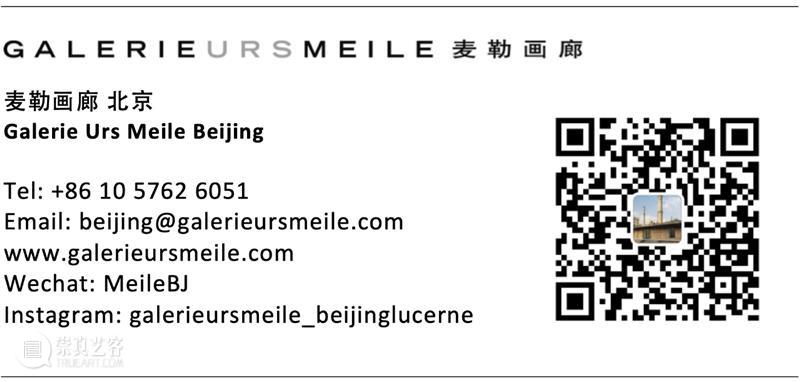

邱世华:自然玄览
Qiu Shihua: Sanctuary
展览时间:
2023.11.25 – 2024.2.18
开幕 Opening:
2023.11.25(周六),16:00 – 18:00
麦勒画廊 北京
Galerie Urs Meile Beijing
(Please scroll down for English)
在当代艺术领域,邱世华(1940年出生于中国四川资中)是充满“谜”之色彩的人物。他成长于中国贫困的西南地区,看似并不太可能成为一位当代艺术家。尽管环境很艰难,但自从他年幼时,绘画就成为了他的庇护所,而且他最初并未接受过正式的学院训练。当时,西方油画在中国还是一门相对较新的学科,艺术教育完全受意识形态的影响。正如他所言,他与社会、体制,以及教育方法论之间的关系并不密。¹在那个艺术基本上由国家控制的时代,他找到了一份剧院海报设计师的工作,但很快又丢了这份工作。回首过往,他说道:“社会已经与我脱节,这并不是我主动选择的。”这使得他开始彻底远离社交生活。
步入不惑之年,他开启了全新的人生,绘画也成为了他唯一且恒久的陪伴。在他迷茫的时刻,他投身于道家,并逐渐形成了他现今的绘画风格。他将这个转变描述为“从极度的痛苦转向极度的喜悦”。生活充满艰辛,但同时也很简单、朴素。绘画似乎再一次成为了他的避风港。
20世纪80年代,随着环境日趋开放,邱世华的作品也逐渐获得了国际认可。在巴黎驻留并学习印象派的机会激励他摆脱传统的风景画,转而在冥想中探究抽象与内省的精神层面的风景。正如他所说:“凝视风景会让思维变得局限。”
千禧年末,他迎来了重大的机遇和突破,并在包括圣保罗双年展(1996年)、威尼斯双年展(1999年)以及巴塞尔美术馆(1999年)等展览中备受国际赞誉。
21世纪初,饱受多年病痛困扰的他接受了西医的治疗,但身体并没有好转,药物带来了严重的副作用。历经多年的痛苦后,他决定停止一切治疗,将剩余的时间和生命全部交给冥想和绘画。绘画再次成为他最后的庇护所,与医生的预测相反,绘画也成为了他的疗愈之所。随后,他在欧洲和美国的重要艺术机构举办了展览,包括德国柏林汉堡车站现代美术馆(2012年)、美国纽约大都会博物馆(2013年)以及瑞士苏黎士里特贝格博物馆(2020年)。
我们不应从传统的方式去理解邱世华的绘画作品。它们是他个人生活经历的反思,更是深层冥想的产物,也是他从生命的体验与挣扎中寻找到的庇护所。他的展览更像是一次又一次的朝圣,而不是常规的艺术展,因为常规的数字印刷和传播以及呈现方式并不适合他独特的创作方法。当下的艺术创作正日渐被市场驱动,艺术教育也变得更趋流线作业,而邱世华的作品正与这些潮流背道而驰,并提醒着我们将艺术视为庇护所的持久力量。他的绘画挑战了我们的传统认知,将我们引向对于艺术思考的另一个维度——超越时间、拒绝分类,最终得以成为艺术家和观众共同的庇护所。他展示了即使是在一个可能与传统渐行渐远的当代世界中对于艺初心的坚守。
时至今日,邱世华依然把大部分时间用于绘画,并往返于中国深圳与美国萨克拉门托。
¹ 艺术家所有陈述均来自库尔特·艾施巴赫 (Kurt Aeschbacher)于邱世华2012年德国柏林汉堡车站现代美术馆个展“White Field”期间进行的采访

邱世华,《无题 》,2010,布面油画,200 x 400 cm
Qiu Shihua, untitled, 2010, oil on canvas, 200 x 400 cm
At the age of 40, he made a fresh start, with painting being the only constant. In his sense of disorientation, he turned to Taoism and gradually developed his current style of painting. He describes the transformation as “from extreme pain to extreme joy.” Life had been hard but simple at the same time. Once again, painting seemed to be his refuge.
Towards the end of the millennium, he achieved a breakthrough, with exhibitions at the São Paolo Biennale (1996), the Venice Biennale (1999), and the Kunsthalle Basel (1999) bringing international acclaim.
In the 2010s, he faced years of a severe illness that did not improve despite treatment with Western medicine and severe side effects. After years of pain, he decided to discontinue all treatments and dedicate his (presumed) remaining time solely to meditation and painting. Once again, painting remained his last refuge, and contrary to doctors’ predictions, it became his place of healing.
What followed were exhibitions at major institutions in Europe and the US such as Hamburger Bahnhof, Berlin, Germany (2012), the Metropolitan Museum of Art, New York, USA (2013) or the Museum Rietberg, Zurich, Switzerland (2020).
Qiu Shihua’s paintings are not to be understood in the traditional sense of the word. They are a reflection of his life experiences, a product of his deep meditation, and a refuge from the struggles that have marked his existence. His exhibitions became a pilgrimage rather than a typical art show, as the conventional methods of digital distribution and presentation simply do not align with his unique approach. In a world increasingly influenced by market-driven art production and streamlined art education, Qiu Shihua’s work stands as a symbol of detachment from these trends and serves as a reminder of the enduring power of art as a sanctuary. His paintings challenge our perceptions and beckon us to contemplate a different dimension of art—one that transcends time, defies classification, and ultimately becomes a refuge for the artist and the audience alike. His legacy lies in his unwavering commitment to the original idea of art as a refuge, even in a contemporary world presumably detached from its roots.
To this day, Qiu Shihua dedicates his time to painting, dividing it between Shenzhen and Sacramento.
¹ All statements of the artist are from an interview with Kurt Aeschbacher on Qiu Shihua’s exhibition “White Field” at Hamburger Bahnhof, Berlin, Germany, 2012.
邱世华
Qiu Shihua

艺 术 家




已展示全部
更多功能等你开启...





 分享
分享